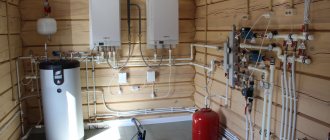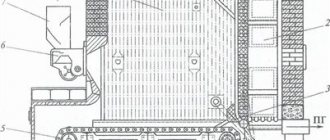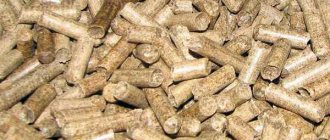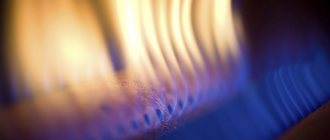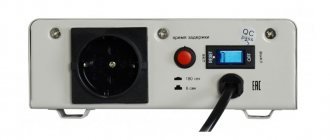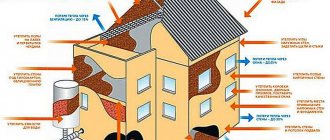Gas is still the cheapest fuel, so if you have a gas main, you should choose a gas boiler without hesitation.
According to surveys and practice, the top three most important selection criteria for most buyers include gas consumption. Despite the fact that it is indicated in the characteristics of almost every modern boiler, this does not allow you to quickly imagine the approximate cost of gas consumed per day, month or for the entire heating season. To make heating budget planning easier, it is enough to once understand the principles of calculating gas consumption by boilers.
What factors affect fuel consumption?
Years of using different types of fuel have proven that gas is 30% cheaper than diesel and electricity. Most users connect to a common pipeline, since when using gas in cylinders, funds are spent on delivery.
Factors that should be taken into account when choosing a heating boiler to avoid high fuel consumption:
- Heat losses. The consumption of a gas boiler directly depends on heat loss through walls, windows, doors, and roof. Therefore, preliminary calculations of the equipment’s power are carried out. The area of the room, the quality of insulation, and the purpose of adjacent rooms are taken into account.
- Settings system. The automatic installation includes sensors that record the external temperature and adjust the operation of the unit in optimal mode. This allows you to save on consumption.
- Type of equipment. When using a condensing unit, gas consumption is reduced by 15–20%. Unlike the conventional convection type, the condenser contains a separate heat exchanger to direct the energy of the combustion products to heat the system. This increases the coefficient of performance (efficiency) to 100%.
The presence of one or two circuits also matters. A single-circuit device works only for heating. Whereas a double-circuit one is used for hot water supply (DHW) and heating. Consequently, its consumption will be greater.
Units with a closed combustion chamber consume less fuel than those with an open combustion chamber. The length of the heating season also affects. After all, in winter the boiler works at maximum, while in summer it works at minimum, only to heat hot water.
Why do appliances consume a lot of gas? This is all due to poor insulation of the building and scale deposits.
The bitter truth about gas consumption in your home
Now you may be surprised, but not a single person will be able to tell you the gas consumption of the boiler in the case of your home. When performing calculations, an experienced specialist will be able to give average values that will be close to the truth, but in any case they will not reflect the exact essence.
This is due to several factors:
- Winter is different from winter every year. Accordingly, the warmer it is, the less will be spent and vice versa.
- 100 square meters in your house and 100 square meters in your neighbor’s house are two completely different houses. Below we will talk about why
- Different boilers have different flow rates
How much energy does a home heating system consume?
If we analyze all the reasons that stimulate the appetite of a heat-generating device, it becomes clear that the boiler’s consumption is primarily affected by its power. A clogged heat receiver, low-calorie gas, severe frosts and an additional circuit force us to increase and increase the boiler power. Therefore, before calculating the flow rate, we must determine the needs of the heating system itself.
And for this you do not need to delve into serious mathematical formulas, taking into account the thermal inertia of the batteries, the thermal resistance of walls, ceilings and windows. For an approximate result, a simple proportion will be enough: 10 square meters. m. = 1 kW. Well, for severe frosts it’s worth adding another 20 percent, adjusting the proportion to 10 m2 = 1.2 kW
How to apply this proportion in practice? Yes, very simple:
- Take a house or apartment plan and calculate the area of all heated rooms (including warm corridors).
- Divide the sum of all areas by 10 and multiply by 1.2. As a result, you will get a number that determines the maximum appetite of the heating circuit.
Finally, round the resulting kilowatts to the nearest value of the boiler’s standard power (7, 10, 12 kW, and so on) and get the desired need, based on which you can calculate how much gas your particular heat generator consumes.
For example, you have three rooms of 18, 12 and 20 square meters. Plus a kitchen of 12 m2 and a corridor of 6 m2. The total is 68 square meters or 8.16 kW. We round this figure to 10 kW and get the required power of the heat generating installation. Now we only have to calculate the gas consumption to generate 1 kW of power.
What determines the boiler's appetite?
Firstly, from its power. The larger it is, the higher the consumption of gas boilers will be. Moreover, you will not be able to reduce the appetite of a heat-generating device by using it. If you purchased a 20 kW gas fireplace, then even at minimum it will consume more than a 10 kW device at maximum. Therefore, be careful when choosing the power of heat-generating devices.
Secondly, from the temperature “overboard”. In this case, the already mentioned power regulator comes into play. After all, at a low temperature in the house, we will try to squeeze the maximum number of calories out of the heating by turning the regulator knob to the maximum. And if in relatively warm (for winter) weather the regulator is set to “one” or “two”, then in 30- or 40-degree frosts it is switched to “five” or even “seven”. And the number of cubic meters of gas passing through the nozzles into the combustion chamber doubles.
Gas consumption by a boiler depends on many factors
Thirdly, on the calorie content of the gas. This value is not controlled by the consumer. Therefore, gas distribution companies sometimes play around with the composition of “blue” fuel. After all, the same compressed nitrogen pumped into the central pipeline costs 2.5-3 times less than natural gas. Now, fortunately, such fraud schemes are no longer practiced, but gas workers can easily supply “undrained” gas with a high content of water vapor and other impurities into the pipes. And if your kettle boils not in 2-3 minutes, but in 5-7, then what can you ask from the heating system? You approach the boiler and turn the power regulator to maximum, closing your eyes to the accelerated rotation of the gas meter disk.
Fourthly, on the technical condition of the heat exchanger. Heating of water or coolant in gas appliances occurs in a heat exchanger - a special copper pipeline located either in the combustion chamber or behind its walls. And if the heat exchanger becomes clogged with scale or scale residues from the batteries, then you will have to add power, compensating for the decreased heat transfer. Moreover, a clogged heat exchanger steals cubic meters much more actively than real or mythical tricksters from a gas distribution company.
Fifthly, on the number of heating circuits. Almost all modern gas boilers have more than one heating circuit. After all, such heat-generating devices serve not only the wiring of the heating system, but also the home hot water supply line. To do this, a second circuit is installed into the structure of the gas hearth and the throughput of the nozzles is increased, increasing the power. And the more power, the higher the consumption.
What volume of gas needs to be burned to generate 1 kW
To answer this question, we need to understand such concepts as the calorific value of gas and the efficiency of the boiler. The first term means the amount of energy released when a kilogram or cubic meter of gas is completely burned.
According to reference books, for the standard main mixture supplied to the boiler, the calorific value is 9.3 kW/m3.
The second term (efficiency) refers to the ability of a heat-generating installation to transfer the energy of burned fuel to the coolant. Typically, gas boilers can transfer no more than 90 percent of the energy of the burned gas to the coolant. Therefore, when burning a cubic meter of gas, the coolant will receive no more than 8.37 kW (9.3x90%).
As a result, about 0.12 m3 of gas (1/8.37) is used to generate 1 kW of thermal power. That is, in order for the heating system to receive 1 kilowatt per hour, the combustion chamber of the boiler must accept and process 0.12 m3 of fuel. Based on this information, we can calculate monthly, daily, and even hourly boiler consumption rates.
Questions about meters
The reasons for such calculations are related to the choice of type and modification of the meter. Even a modest error here can cause negative consequences. Most often there are problems with the functioning of the meter. It is replaced and then the gas pipes are redone.
The type of this device must correspond to the equipment installed in the house.
The meters are marked G. It reflects their power qualities. In fact, it informs you what total gas consumption should occur in the house so that the meter accurately and without failures reflects it.
Example: the apartment has a gas stove. Gas consumption within one hour is in the range of 0.03 - 1.2 cubic meters. It is necessary to install the simplest device in the apartment. Installing a meter with an impressive volume is not reasonable.
If your home has both a gas stove and a boiler or water heater, the picture changes dramatically. And these devices produce completely different indicators. Even if the boiler or boiler consumes natural gas minimally, this parameter will still exceed the maximum value for gas consumption in liters for a stove with 4 burners. Here you will need to install a complex meter designed to work in such conditions.
In homes where complex gas appliances are installed, the minimum gas consumption data is calculated based on the technical properties of the stove. The maximums are calculated in aggregate. The abundance of gas appliances can cause another serious problem: a huge range will appear between the extreme points of consumption.
Example: there is a stove in the house. It operates on natural gas. The heater and boiler operate on the same fuel. Minimum data for calculation (cost per hour) – technical data of the furnace. This is 0.3 cu. m., maximum figures will reach 7.1 cubic meters. Often even greater values are obtained. And there is simply no device to cover such a range.
In such a situation, several devices are installed. A meter with indexes G1.6 is placed on the stove (the power of the meter is 1.6, the stove has 4 burners) or G2.5. Its version G4 (minimum) is mounted on equipment that consumes significant gas. There is a legal subtlety in this situation. When two counters are working, the same number of personal accounts are opened. There are separate payments for them. At the same time, the cost of installing these devices doubles.
The principle of calculations changes in the presence of a boiler with two circuits. The minimum data is determined on the basis of the technical figures of the stove and this apparatus. The difference between the extreme flow rates is more modest. And choosing the right meter is much easier.
Average gas consumption per month, day and hour
If you want to calculate the hourly gas consumption in the boiler, then you simply need to multiply its power by 0.12 m3 (this is exactly how many cubic meters it takes to generate 1 kW). For example, for a 10-kilowatt boiler, the maximum hourly flow rate will be 1.2 m3 (10x0.12). But this formula is no longer suitable for determining the daily norm.
In daily calculations, slightly different parameters are used . After all, the burner of a heat generator will not work 24 hours a day. This is not required of her. Typically, 50 percent is allocated for work and downtime. That is, during the day, the heat generating unit consumes fuel for only 12 hours. Therefore, daily consumption is calculated using the formula: daily consumption is multiplied by 12. For example, the maximum daily portion for a 10-kilowatt boiler will be equal to 14.4 m3 (10x0.12x12).
To calculate how much gas a boiler consumes per month, you simply need to multiply the daily consumption by 30 days. For example, the maximum monthly consumption of a 10-kilowatt boiler is 432 m3 (10x0.12x12x30). That's all. Now you know the maximum consumption rates and can adjust the boiler power to your budget. However, remember that in real life any heat generator operates at 50-75 percent of its power, so you can subtract 25 percent from the proportion calculated using the above formula.
Calculation of heat load by room volume
When the distance between the floors and the ceiling reaches 3 m or more, the previous calculation option cannot be used - the result will be incorrect. In such cases, the heating load is usually calculated according to specific aggregated indicators of heat consumption per 1 m³ of room volume.
The formula and calculation algorithm remain the same, only the area parameter S changes to volume – V:
Accordingly, another indicator of specific consumption q is adopted, related to the cubic capacity of each room:
- room inside the building or with one external wall and window – 35 W/m³;
- corner room with one window – 40 W/m³;
- the same, with two light openings - 45 W/m³.
Now, as an example, let’s determine the heating load of our cottage, taking the ceiling height to be 3 m:
Q = (47.25 x 45 + 63 x 40 + 15 x 35 + 21 x 35 + 18 x 35 + 47.25 x 45 + 63 x 40) x 1 = 11182 W ≈ 11.2 kW.
It is noticeable that the required thermal power of the heating system has increased by 200 W compared to the previous calculation. If we take the height of the rooms to be 2.7-2.8 m and calculate the energy costs per cubic capacity, then the figures will be approximately the same. That is, the method is quite applicable for an aggregated calculation of heat loss in rooms of any height.
How to reduce costs
If you follow our recommendations in the domestic sphere, then you can save on using the boiler:
- Start with choosing a technique. The most economical is a condensing boiler. It saves up to 25% fuel, and efficiency reaches 100–110%. Of course, its cost is much higher, but, according to experts, it will quickly pay for itself. Pay attention to consumer reviews when purchasing. A double-circuit boiler uses 20–25% more thermal energy. Therefore, if the room only needs heating, give preference to a single-circuit installation.
- Take care of insulating the walls, install plastic double-glazed windows. Heat loss through the roof can be easily determined by the build-up of icicles. The more heat goes away, the more icicles there are. In this case, cover the roof and use special materials for insulation.
- Choose modern automatic equipment. It’s not for nothing that manufacturers install sensors, thermostats and regulators. This system works as a single organism, automatically regulating and adjusting the operation of the equipment to the conditions in the room. Timers and special modes allow you to maintain minimum values during vacation or weekend. You can also select the “Winter - Summer” mode.
- Carry out routine maintenance once a year. Be sure to call a specialist for a technical inspection. Clean parts from blockages. Scale accumulations on the heat exchanger contribute to increased thermal energy use. Remove soot and soot from burner nozzles and clean the chimney in a timely manner.
- Install the heat accumulator (TA). This buffer container accumulates coolant and retains heat for a long time (similar to a thermos). Even when the boiler is turned off, the TA will supply liquid to the radiators. Using such a buffer allows you to save 20–30% of fuel.
- Do not select the maximum temperature. Set comfortable indicators, because against the backdrop of average monthly consumption, even 1–2 degrees matter.
This is how the cost of heating a living space is calculated. If you are not sure of the accuracy of the calculations, contact a specialist. He will take into account all the nuances and help you with the selection of economical equipment.
Questions about meters
The reasons for such calculations are related to the choice of type and modification of the meter. Even a modest error here can cause negative consequences. Most often there are problems with the functioning of the meter. It is replaced and then the gas pipes are redone.
The type of this device must correspond to the equipment installed in the house.
The meters are marked G. It reflects their power qualities. In fact, it informs you what total gas consumption should occur in the house so that the meter accurately and without failures reflects it.
Example: the apartment has a gas stove. Gas consumption within one hour is in the range of 0.03 - 1.2 cubic meters. It is necessary to install the simplest device in the apartment. Installing a meter with an impressive volume is not reasonable.
If your home has both a gas stove and a boiler or water heater, the picture changes dramatically. And these devices produce completely different indicators. Even if the boiler or boiler consumes natural gas minimally, this parameter will still exceed the maximum value for gas consumption in liters for a stove with 4 burners. Here you will need to install a complex meter designed to work in such conditions.
In homes where complex gas appliances are installed, the minimum gas consumption data is calculated based on the technical properties of the stove. The maximums are calculated in aggregate. The abundance of gas appliances can cause another serious problem: a huge range will appear between the extreme points of consumption.
Example: there is a stove in the house. It operates on natural gas. The heater and boiler operate on the same fuel. Minimum data for calculation (cost per hour) – technical data of the furnace. This is 0.3 cu. m., maximum figures will reach 7.1 cubic meters. Often even greater values are obtained. And there is simply no device to cover such a range.
In such a situation, several devices are installed. A meter with indexes G1.6 is placed on the stove (the power of the meter is 1.6, the stove has 4 burners) or G2.5. Its version G4 (minimum) is mounted on equipment that consumes significant gas. There is a legal subtlety in this situation. When two counters are working, the same number of personal accounts are opened. There are separate payments for them. At the same time, the cost of installing these devices doubles.
The principle of calculations changes in the presence of a boiler with two circuits. The minimum data is determined on the basis of the technical figures of the stove and this apparatus. The difference between the extreme flow rates is more modest. And choosing the right meter is much easier.
